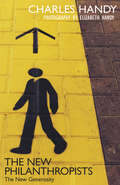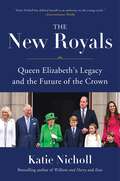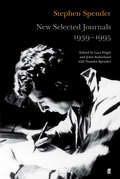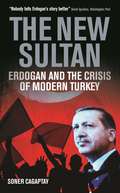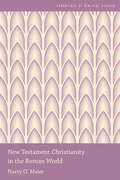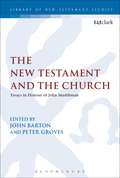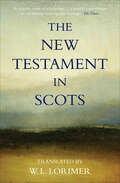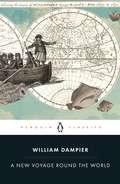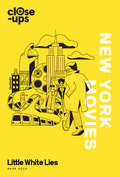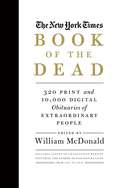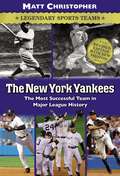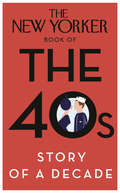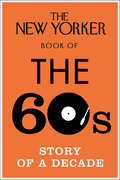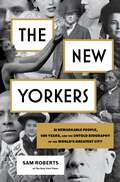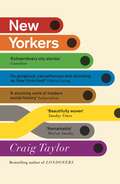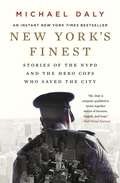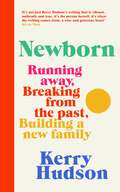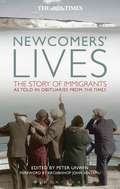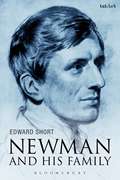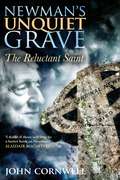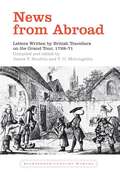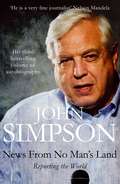- Table View
- List View
The New Philanthropists: The New Generosity
by Charles Handy Elizabeth HandyWho are the new philanthropists? And how is their philanthropy 'new'?In this remarkable and inspiring book, the eminent management writer Charles Handy and his wife Elizabeth, a portrait photographer, have collaborated to portray a new generation of practical philanthropists, men and women who have made their own fortunes and decided to move on from financial success to try to help those in need. They are doing so not simply by giving their money away to charities and agencies but by helping actively, working on the spot with the very people who need their aid, ensuring that the initiatives are sustainable in the longer term.As in their acclaimed The New Alchemists, the Handys have both interviewed and photographed their subjects in order to tell their inspiring stories; from the Sydney restaurateur Jeff Gambin, who personally helps to cook hot and cold menus for homeless people; to Niall Mellon, a young Irish property developer who is replacing the shacks with breeze-block homes in a South African township; and Sara Davenport, who sold her art gallery and set up the breast-cancer care centre the Haven Trust to offer integrated and holistic treatment and support. This striking book of words and photographs reveals the energy and inspiration of these new ways of using wealth, revealing the motivations and satisfactions of such direct action.
The New Royals: Queen Elizabeth's Legacy and the Future of the Crown
by Katie NichollVanity FairRoyals correspondent and bestselling author ofWilliam and HarryandKateexplores the remarkable life and legacy of Queen Elizabeth II, with new chapters to include the last few months of her reign, and the rise of King Charles III. For seventy years, Queen Elizabeth ruled over an institution and a family. During her lifetime she was constant in her desire to provide a steady presence and to be a trustworthy steward of the British people and the Commonwealth. In the face of her uncle&’s abdication, in the uncertainty of the Blitz, and in the tentative exposure of her family and private life to the public via the press, Elizabeth became synonymous with the crown. But times change. Recent years have brought grief and turmoil to the House of Windsor, and even as England celebrated the Queen&’s Platinum Jubilee, there were calls for a changing of the guard. In The New Royals, journalist Katie Nicholl provides a nuanced look at Elizabeth&’s remarkable and unrivalled reign, with new stories from Palace courtiers and aides, documentarians, and family members. She examines King Charles and Queen Consort Camilla&’s decades in waiting and beyond—where &“The Firm&” is headed as William and Kate present the modern faces of an ancient institution. In the wake of Harry and Meghan leaving the Royal Family and Prince Andrew&’s spectacular fall from grace, the royal family must reckon with its history, the light and the dark, in order to chart a course for Britain beyond its Queen and to show that it is an institution capable of leadership in an ever-changing modern world.
New Selected Journals, 1939-1995
by Sir Stephen SpenderPrivate faces in public placesAre wiser and nicerThan public faces in private places.W.H. Auden, dedication to Stephen Spender, 1932Stephen Spender wrote almost a million words of journal entries between his September Journal in 1939 and his death in 1995. In choosing from these voluminous journals for the new edition, the editors have tried to provide a picture of the various lives Spender brought together in autobiographical form.The earlier 1985 edition of the Journals was overseen by the author, and it privileged his thoughts about poetry - his own and other people's. The new edition includes the final ten years of Spender's life and provides access to the more intimate thoughts and feelings of the private man, but equally documents his life as a public intellectual who played a part in shaping the European literary and intellectual culture of his age.As we look back on the dramatic events of the twentieth century, we find that Spender was involved in many of them: the reconstruction of Germany and the construction of Europe (as Unesco's first Literary Councillor), the development of the cultural Cold War (as editor of Encounter), the founding of Israel, the anti-Vietnam movement in America. The Journals provide a personal version of sixty turbulent years of the twentieth century, hovering between diary, autobiography and history.
The New Sultan: Erdogan and the Crisis of Modern Turkey
by Soner CagaptayThe aborted coup in Turkey has fired up interest in a country which will play a critical geopolitical role in the wars of the Middle East. The spotlight will inevitably be on Erdogan – the powerful leader of the country - whose increasingly bizarre and authoritarian regime has increased tensions enormously both within and outside the country. His crackdown has been brutal and consistent – thousands of journalists arrested, academics officially banned from leaving the country, university deans fired and three quarters of highest ranking army officers arrested.In some senses, this coup has given Erdogan the license to make good on his repeated promise to bring order and stability under a 'strongman'. Here, leading Turkish expert Soner Cagaptay will look at where Erdogan comes from in Turkish history, what he believes in, how he has cemented his rule will assess the threats he faces – from the liberal youth to the Gulen movement, the army plotters and the Kurdish question.
NEW TESTAM CHRIST IN ROMAN WORLD EBS C (Essentials of Biblical Studies)
by Harry O. MaierWhat did it mean to be a Christian in the Roman Empire? In one of the inaugural titles of Oxford's new Essentials in Biblical Studies series, Harry O. Maier considers the multilayered social contexts that shaped the authors and audiences of the New Testament. Beginning with the cosmos and the gods, Maier presents concentric realms of influence on the new religious movement of Christ-followers. The next is that of the empire itself and the sway the cult of the emperor held over believers of a single deity. Within the empire, early Christianity developed mostly in cities, the shape of which often influenced the form of belief. The family stood as the social unit in which daily expression of belief was most clearly on view and, finally, Maier examines the role of personal and individual adherence to the religion in the shaping of the Christian experience in the Roman world. In all of these various realms, concepts of sacrifice, belief, patronage, poverty, Jewishness, integration into city life, and the social constitution of identity are explored as important facets of early Christianity as a lived religion. Maier encourages readers to think of early Christianity not simply as an abstract and disconnected set of beliefs and practices, but as made up of a host of social interactions and pluralisms. Religion thus ceases to exist as a single identity, and acts instead as a sphere in which myriad identities co-exist.
The New Testament and the Church: Essays in Honour of John Muddiman (The Library of New Testament Studies #532)
by John Barton Peter GrovesJohn Barton and Peter Groves present a range of chapters by leading scholarly voices from the worlds of biblical studies and the Church, looking at the study of the New Testament within and around the Church and the impact it has had and can have on Christian theology. The essays in the volume adopt a style of critical engagement with biblical texts, through the prism of a modern and living Church. The focus of the volume is thus not only upon the New Testament itself, but upon how reading the New Testament is important for dialogue within the Church and within Christian denominations. Among the highly distinguished contributors are John Barton, Eric Eve, Mark Goodacre, Christopher Rowland, and Rowan Williams.
New Testament Christianity in the Roman World (Essentials of Biblical Studies)
by Harry O. MaierWhat did it mean to be a Christian in the Roman Empire? In one of the inaugural titles of Oxford's new Essentials in Biblical Studies series, Harry O. Maier considers the multilayered social contexts that shaped the authors and audiences of the New Testament. Beginning with the cosmos and the gods, Maier presents concentric realms of influence on the new religious movement of Christ-followers. The next is that of the empire itself and the sway the cult of the emperor held over believers of a single deity. Within the empire, early Christianity developed mostly in cities, the shape of which often influenced the form of belief. The family stood as the social unit in which daily expression of belief was most clearly on view and, finally, Maier examines the role of personal and individual adherence to the religion in the shaping of the Christian experience in the Roman world. In all of these various realms, concepts of sacrifice, belief, patronage, poverty, Jewishness, integration into city life, and the social constitution of identity are explored as important facets of early Christianity as a lived religion. Maier encourages readers to think of early Christianity not simply as an abstract and disconnected set of beliefs and practices, but as made up of a host of social interactions and pluralisms. Religion thus ceases to exist as a single identity, and acts instead as a sphere in which myriad identities co-exist.
The New Testament In Scots: The New Testament In Scots (Canongate Classics #103)
by William L. LorimerEdited by Robin Lorimer, and with a new introduction by James Robertson. The Greek scholar William Lorimer spent the last ten years of his life working on this project. Each Gospel has a different form of Scots to match the different forms of Greek used by the various apostles and scribes, and the vigour and immediacy of the language is everywhere apparent. Transcribed, edited and published by his son Robin Lorimer, this scholarly and dramatically fresh reading of an already familiar text caused a sensation when it first appeared in 1983. Beyond the poetry of the King James version, here are the voices of the disciples themselves, speaking, as they undoubtedly did, in 'plain braid Galilee'.
A New Voyage Round the World: Large Print
by William Dampier'A roaring tale ... remains as vivid and exciting today as it was on publication in 1697' GuardianThe pirate and adventurer William Dampier circumnavigated the globe three times, and took notes wherever he went. This is his frank, vivid account of his buccaneering sea voyages around the world, from the Caribbean to the Pacific and East Indies. Filled with accounts of raids, escapes, wrecks and storms, it also contains precise observations of people, places, animals and food (including the first English accounts of guacamole, mango chutney and chopsticks). A bestseller on publication, this unique record of the colonial age influenced Robinson Crusoe, Gulliver's Travels and consequently the whole of English literature.Edited with an Introduction by Nicholas Thomas
New York Movies (Close-Ups #3)
by Mark Asch Little White LiesThe indispensable, illustrated pocket guide to New York movies, from Martin Scorsese and Woody Allen to Lena Dunham and Noah Baumbach. ALSO AVAILABLE: Close-Ups: Wes Anderson Close-Ups: Vampire Movies
The New York Times Book of the Dead: Obituaries of Extraordinary People
by William McDonaldThe obituary page of The New York Times is a celebration of extraordinary lives. This groundbreaking book includes 300 of the most important and fascinating obituaries the Times has ever published. The obituary page is the section many readers first turn to not only see who died, but to read some of the most inspiring, insightful, often funny, and elegantly written stories celebrating the lives of the men and women who have influenced on our world. William McDonald, The Times' obituary editor who was recently featured in the award-winning documentary Obit, selected 320 of the most important and influential obits from the newspaper's archives. In chapters like "Stage and Screen," "Titans of Business," "The Notorious," "Scientists and Healers," "Athletes," and "American Leaders," the entries include a wide variety of newsmakers from the last century and a half, including Annie Oakley, Theodore Roosevelt, Joseph Stalin, Marilyn Monroe, Coco Chanel, Malcolm X, Jackie Robinson and Prince.
The New York Yankees: Legendary Sports Teams
by Matt ChristopherA revised and expanded edition of The New York Yankees: Legendary Sports Teams! The New York Yankees played their first game in the American League in 1903. Since then, they have become the best team in baseball, bar none. Now this action-packed and fact-filled volume brings the Yankee's great history to life. From Babe Ruth's called shot and Lou Gehrig's tearful farewell speech, to Reggie Jackson's three hits on three pitches and Derek Jeter's game-saving catches, classic moments are recounted with such vivid description that readers will swear they can smell the popcorn and hear the crack of the bat. Updated content includes team records and post-season results from 1903 to 2011, as well as lists of Yankees inducted into the Hall of Famers and photos of the most memorable plays and people in Yankee history.
The New Yorker Book of the 40s: Story of a Decade
by Henry Finder Giles HarveyThe cultural and political history of the watershed decade of the 20th century, as told by the New Yorker.The 1940s were a decade of upheaval and innovation: they saw the Nuremberg Trials and Israeli statehood, Casablanca and Duke Ellington, smallpox and skyscrapers, FDR and Le Corbusier, zoot suits and Christian Dior. It was also the decade the New Yorker came of age. The same magazine offered its readers the first reporting from Hiroshima and introduced the world to Holden Caulfield, while counting John Hersey, Rebecca West, E.B. White, and Joseph Mitchell among its regular writers. In this volume, pieces by the pantheon of journalists, novelists and poets that graced the New Yorker's pages in the 1940s are complemented by all new contributions, as the magazine's present star lineup looks back at that tumultuous decade. Here is a book that will enthrall, inform and entertain any history fan in your life.
The New Yorker Book of the 60s: Story of a Decade
by Edited by Henry FinderThe next instalment in the acclaimed New Yorker 'decades' series featuring an all-star line-up of historical pieces from the 1960s alongside new pieces by current New Yorker staffers.The 1960s, the most tumultuous decade of the twentieth century, were a time of tectonic shifts in all aspects of society – from the March on Washington and the Second Vatican Council to the Summer of Love and Woodstock. No magazine chronicled the immense changes of the period better than The New Yorker. This capacious volume includes historic pieces from the magazine’s pages that brilliantly capture the sixties, set alongside new assessments by some of today’s finest writers.Here are real-time accounts of these years of turmoil: Calvin Trillin reports on the integration of Southern universities, E. B. White and John Updike wrestle with the enormity of the Kennedy assassination and Jonathan Schell travels with American troops into the jungles of Vietnam. The murder of Martin Luther King, Jr., the fallout of the 1968 Democratic Convention, the Soviet invasion of Czechoslovakia, the Six-Day War: all are brought to immediate and profound life in these pages. The New Yorker of the 1960s was also the wellspring of some of the truly timeless works of American journalism. Truman Capote’s In Cold Blood, Rachel Carson’s Silent Spring, Hannah Arendt’s Eichmann in Jerusalem and James Baldwin’s The Fire Next Time all first appeared in The New Yorker and are featured here. The magazine also published such indelible short story masterpieces as John Cheever’s ‘The Swimmer’ and John Updike’s ‘A & P’, alongside poems by Sylvia Plath and Anne Sexton.The arts underwent an extraordinary transformation during the decade, one mirrored by the emergence in The New Yorker of critical voices as arresting as Pauline Kael and Kenneth Tynan. Among the crucial cultural figures profiled here are Simon & Garfunkel, Tom Stoppard, Bob Dylan, Allen Ginsberg, Cassius Clay (before he was Muhammad Ali), and Mike Nichols and Elaine May.The assembled pieces are given fascinating contemporary context by current New Yorker writers, including Jill Lepore, Malcolm Gladwell and David Remnick. The result is an incomparable collective portrait of a truly galvanising era.With contributions from: Truman Capote, John Updike, E.B. White, Rachel Carson, James Baldwin, Jonathan Schell, Dwight Macdonald, Renata Adler, Hannah Arendt, Pauline Kael, AJ Liebling, Nat Hentoff, Calvin Trillin, Xavuer Rynne, John McPhee, Anthony Hiss and more.
The New Yorkers: 31 Remarkable People, 400 Years, and the Untold Biography of the World's Greatest City
by Sam RobertsFrom award-winning New York Times reporter Sam Roberts, the story of the world's most exceptional city, told through 31 little-known yet pivotal inhabitants who helped define it.In Sam Roberts's pulsating history of the world's most exceptional metropolis, greet the city anew through thirty-one unique New Yorkers you've probably never heard of-just in time for the city's 400th birthday. The New Yorkers introduces the first woman to appear nude in a motion picture, becoming the face of Civic Fame as Miss Manhattan; the couple whose soirée ended the Gilded Age with an embarrassing bang; and the husband and wife who invented the modern celebrity talk show. It reveals the victim of the city's first recorded murder in the seventeenth century and the high school dropout who slashed crime rates in the twentieth. The notorious mobster who was imperiously banished from the city and the woman who successfully sued a bus company for racial discrimination a century before Rosa Parks. Some deserved monuments, but their grandeur was overlooked or forgotten. Others shepherded the city through its perpetual evolution, but discreetly. Virtually all have vanished into New York's uncombed history. The New Yorkers is a living biography of the world's greatest city, and no one knows New York better than Sam Roberts-or is better at bringing its history to life.
New Yorkers: A City and Its People in Our Time
by Craig Taylor'Beautifully woven' Sunday Times'Extraordinary city stories ... ambitious and entertaining ... [Taylor] does a fine job of telling the New York story' GuardianA symphony of contemporary New York told through the magnificent words of its people - from the best-selling author of Londoners.In the first twenty years of the twenty-first century, New York City has been convulsed by terrorist attack, blackout, hurricane, recession, social injustice, and pandemic. New Yorkers weaves the voices of some of the city's best talkers into an indelible portrait of New York in our time - and a powerful hymn to the vitality and resilience of its people. Vibrant and bursting with life, New Yorkers explores the nonstop hustle to make it; the pressures on new immigrants, people of colour, and the poor. It captures the strength of an irrepressible city that - no matter what it goes through - dares call itself the greatest in the world. Drawn from millions of words, hundreds of interviews, and six years in the making, New Yorkers is a grand portrait of an irrepressible city and a hymn to the vitality and resilience of its people.
New York's Finest: Stories of the NYPD and the Hero Cops Who Saved the City
by Michael DalyThe gritty, true blue story of two remarkable cops and an equally extraordinary nurse who provided the spirit and smarts that transformed Fear City into the safest big city in America.
Newborn: Running Away, Breaking with the Past, Building a New Family
by Kerry Hudson‘It was always going to be difficult to follow Lowborn, but Kerry Hudson is Kerry Hudson and she has done it – cleverly, honestly, brilliantly’ RODDY DOYLE'Filled with colour: food, Prague, illness, love, the challenges of having a baby in a foreign country and making your own story' AMY LIPTROTIn Newborn, prizewinning writer Kerry Hudson navigates trying to build a nourishing, safe and loving family - without a blueprint to work fromKerry Hudson is celebrated for her emotionally and politically powerful writing about growing up in poverty. Her books and journalism have changed the conversation and touched countless lives.In this new book she asks: what next, after a childhood like hers? What hope is there of creating a different life for herself, let alone future generations? We see how Kerry found love, what it took to decide to start a family of her own and how fragile every step of the journey towards parenthood was. All along the way, she faces obstacles that would test the strongest foundations, from struggles with fertility to being locked down in a Prague maternity hospital to a marriage in crisis. But over and over again, her love, hope, fight -- and determination to break patterns and give her son a different life -- win through and light her path.Newborn is a beautiful, empowering memoir about creating a family in the midst of chaos, and learning new ways to find happiness. It continues the journey Kerry started in her bestselling memoir Lowborn, illuminating her experiences of becoming a mother, reshaping her future and reclaiming her identity.PRAISE FOR KERRY HUDSON:‘It’s not just Kerry Hudson’s writing that is vibrant, authentic and true, it’s the person herself, it’s where the writing comes from; a wise and generous heart’ KIT DE WAAL'Hudson’s resilience, grace and humility are staggering. She’s an absolute inspiration’ DOUGLAS STUART‘Kerry Hudson blew me away, opened my eyes’ PHILIPPA PERRY
Newcomers' Lives: The Story of Immigrants as Told in Obituaries from The Times
by Peter UnwinTo mention the names Ernst Gombrich, Nikolaus Pevsner, Joseph Conrad, Nancy Astor, C.L.R. James and Lucian Freud is to give but a brief glimpse of the impact immigrants to this country have made on our national culture and character. Indeed, these people have been crucial to the development of recent British history and have been indispensable for the way we live now. By reproducing the Times obituaries of over one hundred of the most important of these, the reader is given a unique view of their contribution and it is clear how their contribution has been a determinant factor in British history. The book covers politics, business, art, architecture, music and sport as well as philosophy and religion. The breadth and depth of the influence of immigrants is thus reinforced. The Archbishop of York, John Sentamu, contributes a fascinating introduction surveying our historial and cultural landscape.
Newman and his Family
by Edward ShortA study in family history and influence, Newman and his Family looks at how John Henry Newman (1801-90), the priest, educator, theologian, philosopher, novelist, poet and satirist both learned from and was transformed by his parents and his brothers and sisters. The son of a banker in the City of London and a Huguenot mother whose family were famous and innovative paper makers and printers, Newman was the eldest of six children, two boys and three girls--Charles, Harriett, Frank, Jemima and Mary. While the family was reared Anglican, Charles abandoned Christianity for Owenite Socialism and Frank ended his days a Unitarian. Although Mary died young, she had a profound influence on her brother, as did Harriett, who could never reconcile herself to her brother's conversion. Jemima was also opposed to his conversion, though she lived long enough to witness (from afar) his strange, tumultuous new life as a Catholic. At the same time, since none of the family followed their eldest brother into the Catholic Church, to which Newman converted in 1845, the book also explores the limitations of Newman's influence and the ways in which family differences led him to a deeper understanding of such themes as home and ostracism, failure and faith, conversion and apostasy, disunity and prayer, infirmity and love. Based on Newman's vast correspondence and the correspondence of his different family members, as well as on his published and unpublished writings, Newman and his Family presents the great religious thinker in a freshly personal light, where he can be seen sharing his theological and philosophical convictions directly with those to whom he was most closely tied. While there are excellent studies available on different aspects of Newman and his work, this is the first full-length study to show how the difficulties and heartbreaks inherent in family life helped Newman to understand not only himself and his contemporaries but his deeply personal Christian faith.
Newman and his Family
by Edward ShortA study in family history and influence, Newman and his Family looks at how John Henry Newman (1801-90), the priest, educator, theologian, philosopher, novelist, poet and satirist both learned from and was transformed by his parents and his brothers and sisters. The son of a banker in the City of London and a Huguenot mother whose family were famous and innovative paper makers and printers, Newman was the eldest of six children, two boys and three girls--Charles, Harriett, Frank, Jemima and Mary. While the family was reared Anglican, Charles abandoned Christianity for Owenite Socialism and Frank ended his days a Unitarian. Although Mary died young, she had a profound influence on her brother, as did Harriett, who could never reconcile herself to her brother's conversion. Jemima was also opposed to his conversion, though she lived long enough to witness (from afar) his strange, tumultuous new life as a Catholic. At the same time, since none of the family followed their eldest brother into the Catholic Church, to which Newman converted in 1845, the book also explores the limitations of Newman's influence and the ways in which family differences led him to a deeper understanding of such themes as home and ostracism, failure and faith, conversion and apostasy, disunity and prayer, infirmity and love. Based on Newman's vast correspondence and the correspondence of his different family members, as well as on his published and unpublished writings, Newman and his Family presents the great religious thinker in a freshly personal light, where he can be seen sharing his theological and philosophical convictions directly with those to whom he was most closely tied. While there are excellent studies available on different aspects of Newman and his work, this is the first full-length study to show how the difficulties and heartbreaks inherent in family life helped Newman to understand not only himself and his contemporaries but his deeply personal Christian faith.
Newman's Unquiet Grave: The Reluctant Saint
by John CornwellJohn Henry Newman was the most eminent English-speaking Christian thinker and writer of the past two hundred years. James Joyce hailed him the 'greatest' prose stylist of the Victorian age.A problematic campaign to canonise Newman started fifty years ago. After many delays John Paul II declared him a 'Venerable'. Then Pope Benedict XVI, a keen student of Newman's works, pressed for his beatification. But was Newman a 'Saint'?In Newman's Unquiet Grave John Cornwell (author of A Thief in the Night and Hitler's Pope) tells the story of the chequered attempts to establish Newman's sanctity against the background of major developments within Catholicism. His life was marked by personal feuds, self-absorption, accusations of professional and artistic narcissism, hypochondria, and same-sex friendships that at times bordered on the apparent homo-erotic.John Cornwell investigates the process of Newman's elevation to sainthood to present a highly original and controversial new portrait of the great man's life and genius for a new generation of religious and non-religious readers alike.
Newman's Unquiet Grave: The Reluctant Saint
by John CornwellJohn Henry Newman was the most eminent English-speaking Christian thinker and writer of the past two hundred years. James Joyce hailed him the 'greatest' prose stylist of the Victorian age.A problematic campaign to canonise Newman started fifty years ago. After many delays John Paul II declared him a 'Venerable'. Then Pope Benedict XVI, a keen student of Newman's works, pressed for his beatification. But was Newman a 'Saint'?In Newman's Unquiet Grave John Cornwell (author of A Thief in the Night and Hitler's Pope) tells the story of the chequered attempts to establish Newman's sanctity against the background of major developments within Catholicism. His life was marked by personal feuds, self-absorption, accusations of professional and artistic narcissism, hypochondria, and same-sex friendships that at times bordered on the apparent homo-erotic.John Cornwell investigates the process of Newman's elevation to sainthood to present a highly original and controversial new portrait of the great man's life and genius for a new generation of religious and non-religious readers alike.
News from Abroad: Letters Written by British Travellers on the Grand Tour, 1728–71 (Eighteenth-Century Worlds #3)
by James Boulton T. O. McLoughlinThis book provides a selection of private letters written to family and friends from a variety of people while they were on the Grand Tour in the eighteenth century. Although many have been published previously, this is the first time that letters of this kind have been brought together in a single volume. Readers can compare the various responses of travellers to the sights, pleasures and discomforts encountered on the journey. People of diverse backgrounds, with different expectations and interests, give personal accounts of their particular experiences of the Grand Tour. Unlike most collections of letters from the Tour, which recount the views of a single person, this selection emphasises diversity. Readers can juxtapose for example the letters of a conscientious young nobleman like Lyttelton with those of the excitable philanderer Boswell, or the well-travelled aristocratic lady, Caroline Lennox. While the travellers represented here follow much the same route via Paris, through France and across the Alps via the terrifying Mount Cenis, to Rome, in the pursuit of learning and pleasure, the Tour turns out to mean something quite different to each of them.
News from No Man's Land: Reporting the World
by John SimpsonOn 13 November 2001, John Simpson and a BBC news crew walked into Kabul and the liberation of the Afghan capital was broadcast to a waiting world. It was the end of a sustained campaign against the Taliban, a campaign that Simpson had covered from the beginning, despite appalling difficulties and, often, great danger. In this, his third riveting volume of autobiography, John Simpson focuses on how journalists set about finding the stories that make the headlines. It is quintessential Simpson: vivid, utterly absorbing and written with all the care and lucidity of his reporting style. 'Great stories told with great gusto...an easy and rewarding read' Jon Snow, Daily Mail.
